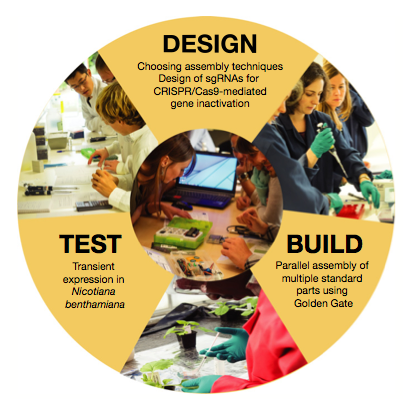The Arabdopsis Research Roundup broadens its remit this week. As well as including three original research papers, which look at casparian strip formation, light and hormone signaling, we also highlight an important viewpoint article that aims to set standards for synthetic biology parts. In addition we include a meeting report from a plant synthetic biology summer school and interviews with plant scientists at the JIC, Caroline Dean and Anne Osbourn.
Kamiya T, Borghi M, Wang P, Danku JM, Kalmbach L, Hosmani PS, Naseer S, Fujiwara T, Geldner N, Salt DE (2015) The MYB36 transcription factor orchestrates Casparian strip formation Proc Natl Acad Sci USA http://dx.doi.org/10.1073/pnas.1507691112 Open Access
GARNet Advisory Board Chairman David Salt (Aberdeen) leads this international collaboration that looks at the (relatively) poorly understood Casparian strip (CS), a lignin-based filter that lies in root endodermal cells. Formation of the CS is initiated by Casparian strip domain proteins (CASPs) that recruit other proteins, which begin the process of lignin deposition. In this study the authors look upstream this process and identify the transcription factor MYB36 that directly regulates expression of CASPs and is essential for CS formation. Ectopic expression of MYB36 in root cortical tissues is sufficient to stimulate expression of CASP1-GFP and subsequent deposit a CS-like structure in the cell wall of cortex cells. These results have implications for the design of future experiments that aim to control how nutrients are taken up by the plant as even though myb36 mutants have a ‘root-defect’, they also have changes to their leaf ionome.
Sadanandom A, Ádám É, Orosa B, Viczián A, Klose C, Zhang C, Josse EM, Kozma-Bognár L, Nagy F (2015) SUMOylation of phytochrome-B negatively regulates light-induced signaling in Arabidopsis thaliana Proc Natl Acad Sci USA http://dx.doi.org/10.1073/pnas.1415260112 Open Access
Ari Sadanandom (Durham) and Ferenc Nagy (Edinburgh) are the leaders of this study that investigates the precise function of the PhyB photoreceptor protein. PhyB interacts with a wide range of downstream signaling partners including the PHYTOCHROME INTERACTING FACTOR (PIF) transcription factors. The small ubiquitin-like modifier (SUMO) peptide is conjugated to larger proteins to bring about a variety of signaling outcomes. In this case the authors find that SUMO is preferentially attached to the C-term of PhyB under red light conditions, a relationship that occurs in a diurnal pattern. SUMOylation of PhyB prevents interaction with PIF5 whilst the OVERLY TOLERANT TO SALT 1 (OTS1) protein likely de-SUMOlyates PhyB in vivo. Altered levels of PhyB SUMOylation cause distinct light-responsive phenotypes and as such this paper adds another level of regulation to the already complex known network that controls light signaling.
Schuster C, Gaillochet C, Lohmann JU (2015) Arabidopsis HECATE genes function in phytohormone control during gynoecium development Development. http://dx.doi.org/10.1242/dev.120444 Open Access
Christopher Schuster who is now a postdoc based at the Sainsbury lab in Cambridge is the lead author on this investigation into the role of the HECATE (HEC) family of bHLH transcription factors on fruit development in Arabidopsis. During this process HEC proteins are involved in the response to both the phytohormones auxin and cytokinin, the authors proposing that HEC1 plays an essential role in Arabidopsis gynoecium formation.
Patron N et al (2015) Standards for plant synthetic biology: a common syntax for exchange of DNA parts New Phytologist http://dx.doi.org/10.1111/nph.13532 Open Access
Carmichael RE, Boyce A, Matthewman C Patron N (2015) An introduction to synthetic biology in plant systems New Phytologist http://dx.doi.org/10.1111/nph.13433 Open Access
Although not strictly based on Arabdopsis work, there are a couple of articles in New Phytologist that have broad relevance to plant scientists who are interested in plant synthetic biology. In the first of these Nicola Patron (The Sainsbury Laboratory) leads a wide consortium that aims to set parameters for the standardisation of parts in plant synthetic biology. It is hoped that as the principles of synbio are used more widley in the plant sciences that the proposals in this paper will serve as a useful guide to standidise part production. GARNet has recently written a blog post on this topic.

The associated meeting report looks at the use of plant synthetic biology in a teaching context with a synopsis of the ERASynBio summer school hosted by John Innes Centre. In this event, young researchers from a range of backgrounds were introduced to the power and potential of plant synthetic biology through a diverse course of lectures, practical session and group projects.
Vicente C (2015) An interview with Caroline Dean Development http://dx.doi.org/10.1242/dev.127548 Open Access
An interview with Anne Osbourn (2015) New Phytologist <a href="http://dx.doi acheter cialis.org/10.1111/nph.13616″ onclick=”_gaq.push([‘_trackEvent’, ‘outbound-article’, ‘http://dx.doi.org/10.1111/nph.13616’, ‘http://dx.doi.org/10.1111/nph.13616 ‘]);” target=”_blank”>http://dx.doi.org/10.1111/nph.13616 Open Access
These are interviews with eminent female plant molecular biologists who both work at the John Innes Centre. Caroline Dean’s lab focuses on the epigenetic mechanisms that regulate vernalisation whilst Anne Osbourn is interested in using synthetic biology approaches to engineer metabolic pathways for the production of novel compounds.

Interested in the standards for biology synthesis for taking reference inchemistry synthesis